Satas D., Tracton A.A. (ed.). Coatings Technology Handbook
Подождите немного. Документ загружается.

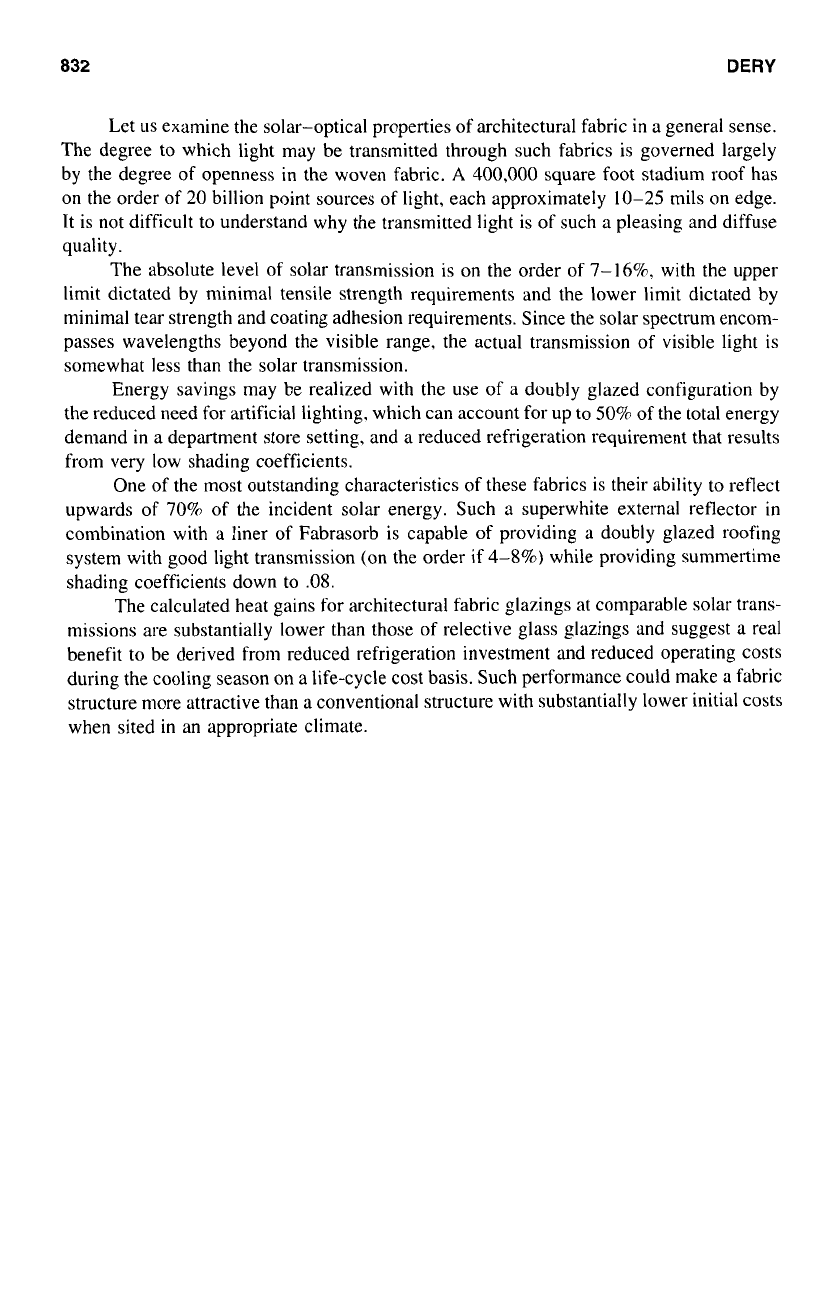
832
DERY
Let us examine the solar-optical properties
of
architectural fabric
in
a general sense.
The degree to which light may be transmitted through such fabrics is governed largely
by the degree of openness in the woven fabric.
A
400,000
square foot stadium roof has
on the order of 20 billion point sources of light, each approximately 10-25 mils on edge.
It is not difficult to understand why the transmitted light is of such a pleasing and diffuse
quality.
The absolute level of solar transmission is on the order of
7-1670,
with the upper
limit dictated by minimal tensile strength requirements and the lower limit dictated by
minimal tear strength and coating adhesion requirements. Since the solar spectrum encom-
passes wavelengths beyond the visible range. the actual transmission
of
visible light is
somewhat less than the solar transmission.
Energy savings may be realized with the use of a doubly glazed configuration by
the reduced need for artificial lighting, which can account for up to 50%
of
the total energy
denland
in
a department store setting, and a reduced refrigeration requirement that results
from very low shading coefficients.
One
of
the most outstanding characteristics of these fabrics is their ability
to
reflect
upwards
of
70%
of
the incident solar energy. Such a superwhite external reflector in
combination with a liner of Fabrasorb
is
capable
of
providing a doubly glazed roofing
system with good light transmission
(on
the order if 4-8%) while providing summertime
shading coefficients down to .08.
The calculated heat gains for architectural fabric glazings at comparable solar trans-
missions are substantially lower than those of relective glass glazings and suggest a real
benefit
to
be derived from reduced refrigeration investment and reduced operating costs
during the cooling season on a life-cycle cost basis. Such performance could make a fabric
structure more attractive than a conventional structure with substantially lower initial costs
when sited
in
an appropriate climate.
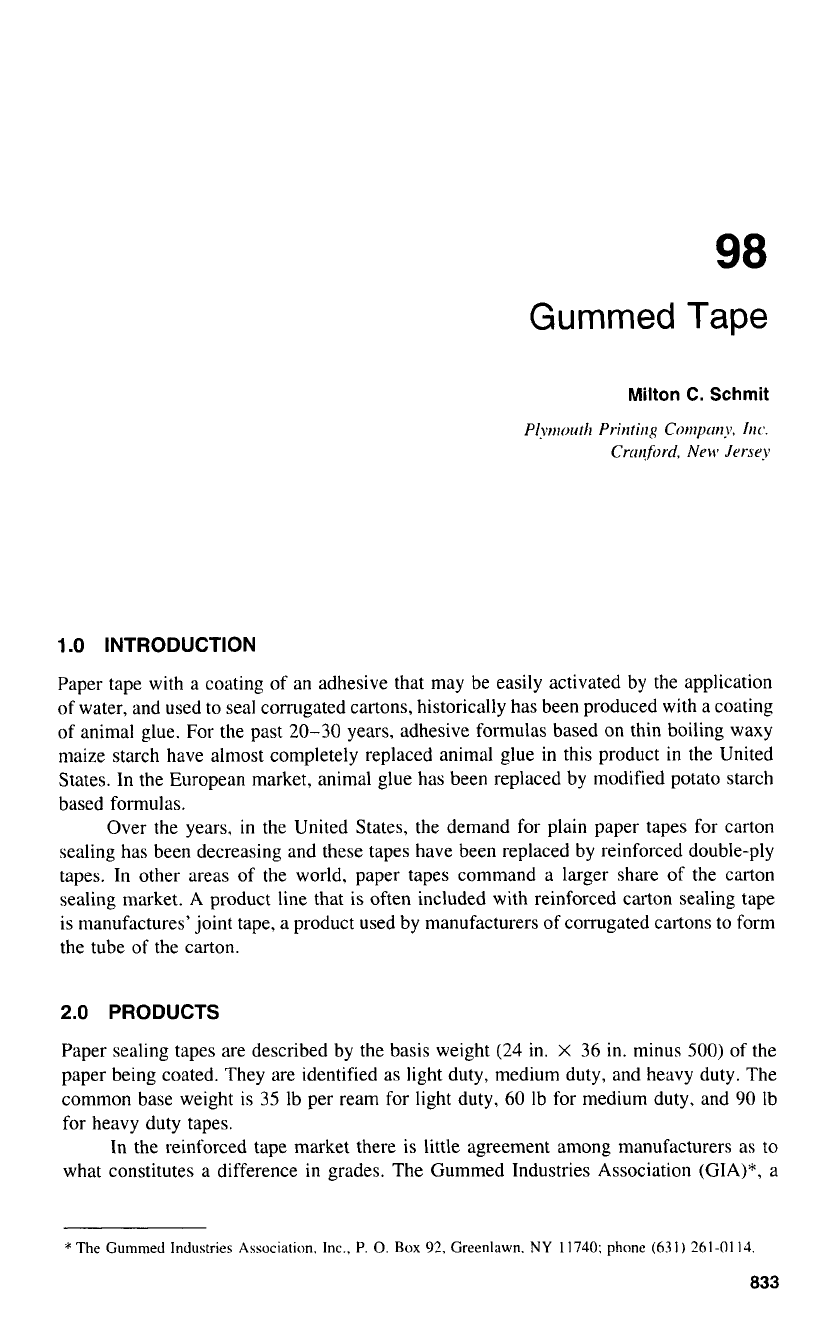
Gummed
Tape
1
.O
INTRODUCTION
Paper tape with a coating of an adhesive that may be easily activated by the application
of
water, and used to seal corrugated cartons, historically has been produced with a coating
of
animal glue. For the past
20-30
years, adhesive formulas based on thin boiling waxy
maize starch have almost completely replaced animal glue in this product
in
the United
States. In the European market, animal glue has been replaced by modified potato starch
based formulas.
Over the years,
in
the United States, the demand for plain paper tapes for carton
sealing has been decreasing and these tapes have been replaced by reinforced double-ply
tapes. In other areas of the world, paper tapes command a larger share
of
the carton
sealing market. A product line that is often included with reinforced carton sealing tape
is manufactures’ joint tape, a product used by manufacturers of corrugated cartons to form
the tube
of
the carton.
2.0
PRODUCTS
Paper sealing tapes are described by the basis weight
(24
in.
X
36
in.
minus
500)
of the
paper being coated. They are identified as light duty, medium duty, and heavy duty. The
common base weight is
35
lb per ream for light duty,
60
Ib for medium duty, and
90
Ib
for heavy duty tapes.
In the reinforced tape market there
is
little agreement among manufacturers as to
what constitutes
a
difference in grades. The Gummed Industries Association (GIA)*,
a
~ ~~~ ~ ~
*
The Gummed Industries Association, Inc.,
P.
0.
Box
92,
Greenlawn.
NY
11740;
phone
(631
)
261-01
14.
833
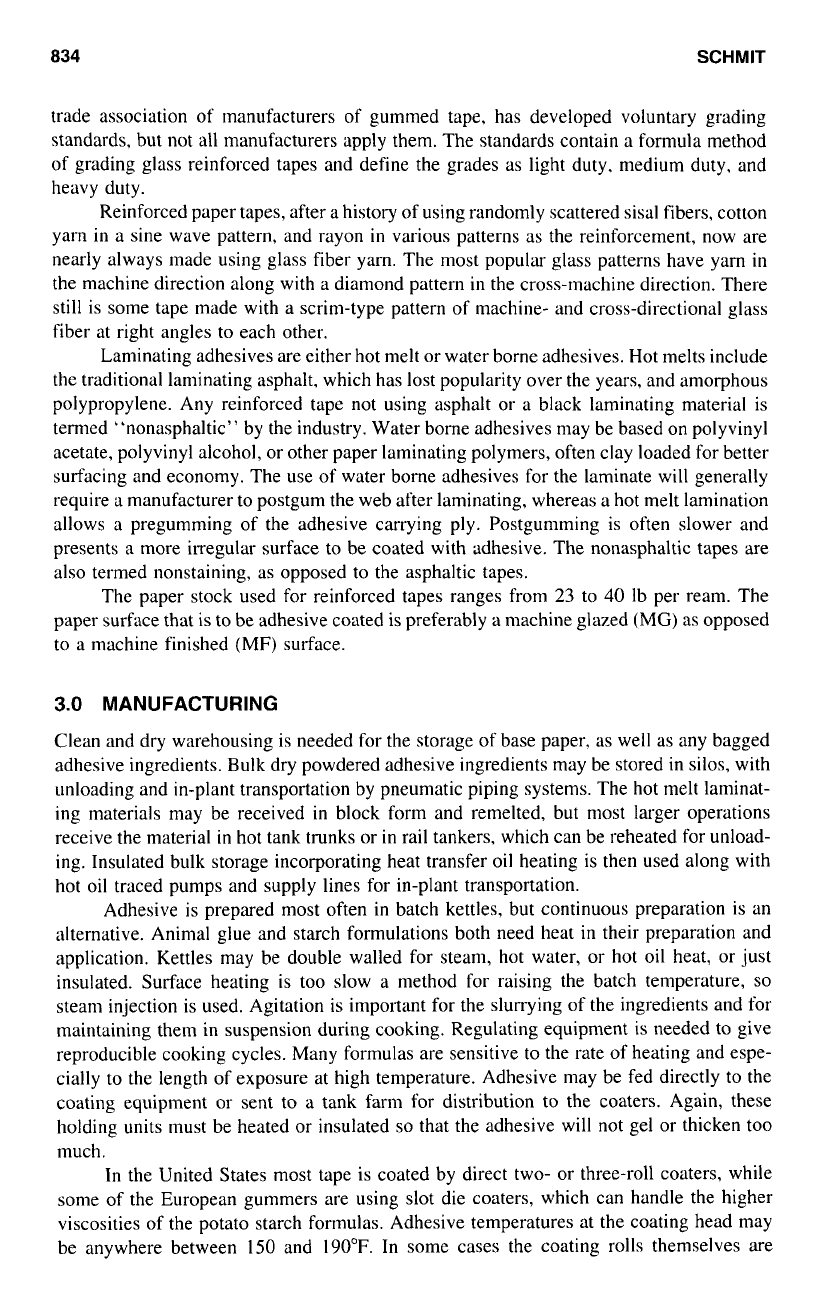
a34
SCHMIT
trade association of manufacturers of gummed tape, has developed voluntary grading
standards, but not all manufacturers apply them. The standards contain
a
formula method
of grading glass reinforced tapes and define the grades as light duty. medium duty, and
heavy duty.
Reinforced paper tapes, after
a
histoly
of
using randomly scattered sisal fibers, cotton
yarn in
a
sine wave pattern, and rayon
in
various patterns
as
the reinforcement, now are
nearly always made using glass fiber yarn. The most popular glass patterns have yarn in
the machine direction along with a diamond pattern in the cross-machine direction. There
still is some tape made with a scrim-type pattern of machine- and cross-directional glass
fiber at right angles
to
each other.
Laminating adhesives are either hot melt or water borne adhesives. Hot melts include
the traditional laminating asphalt, which has lost popularity over the years, and amorphous
polypropylene. Any reinforced tape
not
using asphalt or a black laminating material is
termed “nonasphaltic” by the industry. Water borne adhesives may be based
on
polyvinyl
acetate, polyvinyl alcohol, or other paper laminating polymers, often clay loaded for better
surfacing and economy. The use of water borne adhesives for the laminate will generally
require a manufacturer to postgum the web after laminating, whereas a hot melt lamination
allows a pregumming of the adhesive carrying ply. Postgumming is often slower and
presents a more irregular surface to be coated with adhesive. The nonasphaltic tapes are
also termed nonstaining, as opposed
to
the asphaltic tapes.
The paper stock used for reinforced tapes ranges from
23
to
40
Ib per ream. The
paper surface that is to be adhesive coated is preferably a machine glazed (MG)
as
opposed
to a machine finished
(MF)
surface.
3.0
MANUFACTURING
Clean and dry warehousing is needed for the storage
of
base paper, as well
as
any bagged
adhesive ingredients. Bulk dry powdered adhesive ingredients may be stored in silos, with
unloading and in-plant transportation by pneumatic piping systems. The hot melt laminat-
ing materials may be received
in
block form and remelted, but most larger operations
receive the material
in
hot tank trunks or
in
rail tankers, which can be reheated for unload-
ing. Insulated bulk storage incorporating heat transfer oil heating is then used along with
hot oil traced pumps and supply lines for in-plant transportation.
Adhesive is prepared most often in batch kettles, but continuous preparation is an
alternative. Animal glue and starch formulations both need heat in their preparation and
application. Kettles may be double walled for steam, hot water, or hot
oil
heat, or just
insulated. Surface heating is too slow a method for raising the batch temperature,
so
steam injection is used. Agitation is important for the slurrying of the ingredients and for
maintaining them in suspension during cooking. Regulating equipment is needed to give
reproducible cooking cycles. Many formulas are sensitive
to
the rate of heating and espe-
cially to the length of exposure at high temperature. Adhesive may be fed directly
to
the
coating equipment or sent to a tank farm for distribution to the coaters. Again, these
holding units must be heated or insulated
so
that the adhesive will
not
gel or thicken
too
much.
In
the United States most tape is coated by direct two- or three-roll coaters, while
some of the European gummers are using slot die coaters, which can handle the higher
viscosities of the potato starch formulas. Adhesive temperatures at the coating head may
be anywhere between
150
and
190°F.
In some cases the coating rolls themselves are
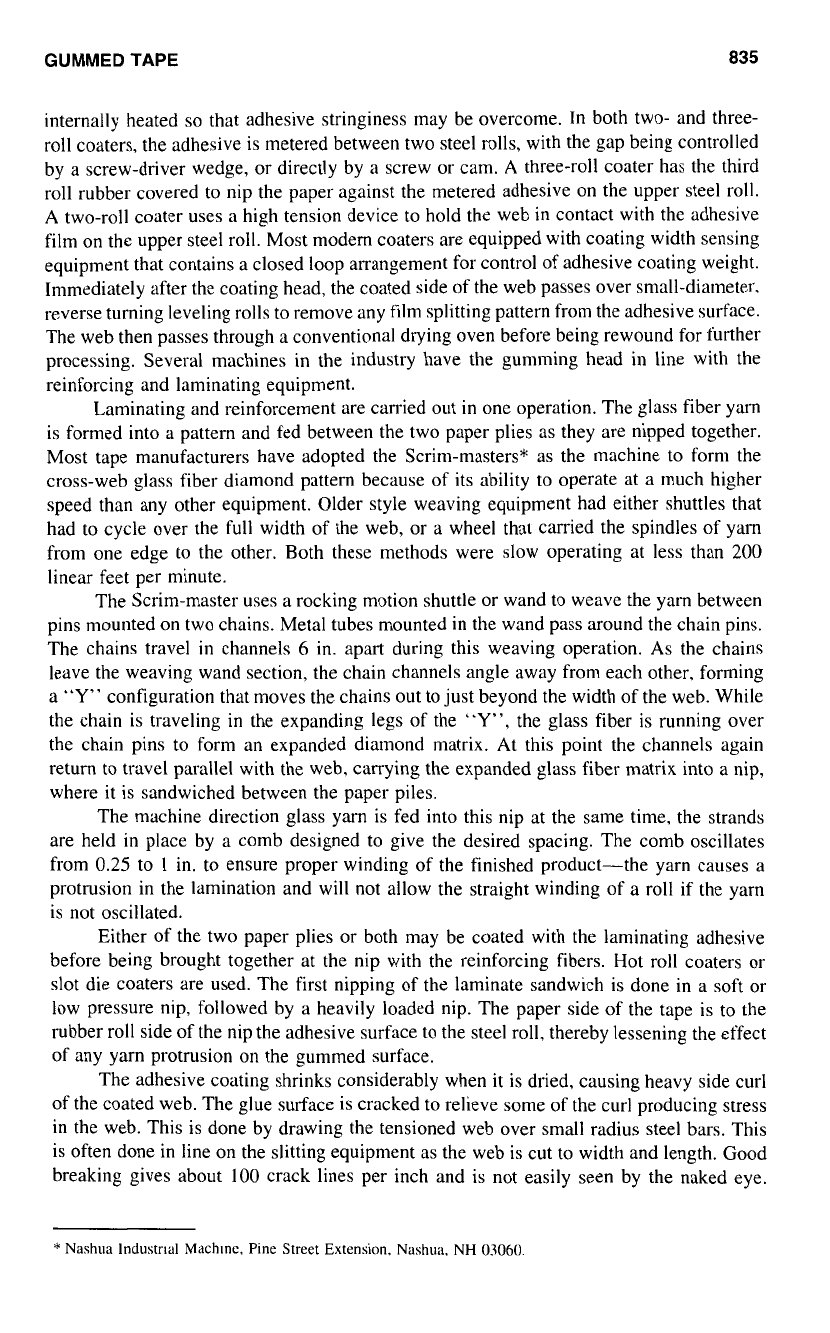
GUMMED TAPE
835
internally heated
so
that adhesive stringiness may be overcome. In both two- and three-
roll coaters, the adhesive is metered between two steel rolls, with the gap being controlled
by
a
screw-driver wedge, or directly by
a
screw or cam.
A
three-roll coater has the third
roll rubber covered
to
nip the paper against the metered adhesive on the upper steel roll.
A
two-roll coater uses
a
high tension device to hold the web in contact with the adhesive
film
on
the upper steel roll. Most modem coaters are equipped with coating width sensing
equipment that contains
a
closed loop arrangement for control of adhesive coating weight.
Immediately after the coating head, the coated side of the web passes over small-diameter.
reverse turning leveling rolls to remove any film splitting pattern from the adhesive surface.
The web then passes through
a
conventional drying oven before being rewound for further
processing. Several machines in the industry have the gumming head in line with the
reinforcing and laminating equipment.
Laminating and reinforcement are carried out
in
one operation. The glass fiber yarn
is formed into
a
pattern and fed between the two paper plies
as
they are nipped together.
Most tape manufacturers have adopted the Scrim-masters*
as
the machine to form the
cross-web glass fiber diamond pattern because
of
its ability
to
operate at
a
much higher
speed than any other equipment. Older style weaving equipment had either shuttles that
had
to
cycle over the
full
width of the web, or a wheel that carried the spindles
of
yarn
from one edge to the other. Both these methods were slow operating at less than
200
linear feet per minute.
The Scrim-master uses
a
rocking motion shuttle or wand to weave the yarn between
pins mounted
on
two chains. Metal tubes mounted
in
the wand pass around the chain pins.
The chains travel
in
channels
6
in. apart during this weaving operation.
As
the chains
leave the weaving wand section, the chain channels angle away from each other, forming
a
“Y”
configuration that moves the chains out to just beyond the width of the web. While
the chain is traveling
in
the expanding legs of the
“Y”,
the glass fiber is running over
the chain pins to form an expanded diamond matrix. At this point the channels again
return to travel parallel with the web, carrying the expanded glass fiber matrix into
a
nip,
where it is sandwiched between the paper piles.
The machine direction glass yarn is fed into this nip at the same time, the strands
are held in place by a comb designed to give the desired spacing. The comb oscillates
from
0.25
to
1
in.
to
ensure proper winding
of
the finished product-the yarn causes
a
protrusion in the lamination and will not allow the straight winding of
a
roll if the yarn
is not oscillated.
Either of the two paper plies or both may be coated with the laminating adhesive
before being brought together at the nip with the reinforcing fibers. Hot roll maters or
slot
die coaters are used. The first nipping of the laminate sandwich is done in
a
soft or
IOW
pressure nip, followed by
a
heavily loaded nip. The paper side
of
the tape is to the
rubber roll side of the nip the adhesive surface to the steel roll, thereby lessening the effect
of any yarn protrusion on the gummed surface.
The adhesive coating shrinks considerably when
it
is dried, causing heavy side curl
of the coated web. The glue surface is cracked
to
relieve some of the curl producing Stress
in
the web. This is done by drawing the tensioned web over small radius steel bars. This
is often done
in
line on the slitting equipment
as
the web is Cut to width and length. Good
breaking gives about
100
crack lines per inch and is not easily seen by the naked eye.
*
Nashua
lndustrlal Machlnc. Pine Street Extension.
Nashua.
NH
03060

836 SCHMIT
Before slitting, a secondary machine may be used
to
pass the tensioned web over bars set
at an angle to the web
(30-45"
is common), and then over a 90" bar. This gives a three-
directional breaking pattern. To control the breaking and to prevent
a
pigtail curl from
developing, the tension over each bar may need to be independently controlled and the
radius of the bars may need to be different.
Plain paper tapes, reinforced tapes, and manufacturer's joint tapes are usually sup-
plied
in
a nominal
3
in. width, with some grades being readily available also in 2.5 in.
width.
Roll
length is highly variable, ranging from
375
to
800
linear feet for products
used
in
the common bench type
of
tape wetting devices, while rolls for automatic taping
equipment are run to lengths to give diameters of 20-24
in.
Most slitting of tape is done
on
single-shaft rewinders and with score cut knives.
There is some shear cut slitting done as well. The smaller diameter rolls may be on cores
or coreless, with inside diameters of
l
.25-
1.75
in. Larger diameter rolls are generally on
cores with
a
wall thickness
of
at least
0.125
in. and an inside diameter the same as the
small
rolls
or a
3
in. inside diameter core.
A
bowed roller mounted between the slitter
knives and the windup will cause the individual webs to separate slightly and help to
separate the log of rolls when the shaft is removed.
'
Roll
separation, inspection, and packing are done manually with no automation,
except for carton sealing in some plants. The cartons are identified by a lot number
so
that any complaints can be traced through the manufacturing cycle. Finished product is
palletized and stretch wrapped or shrink wrapped for shipping or warehousing.
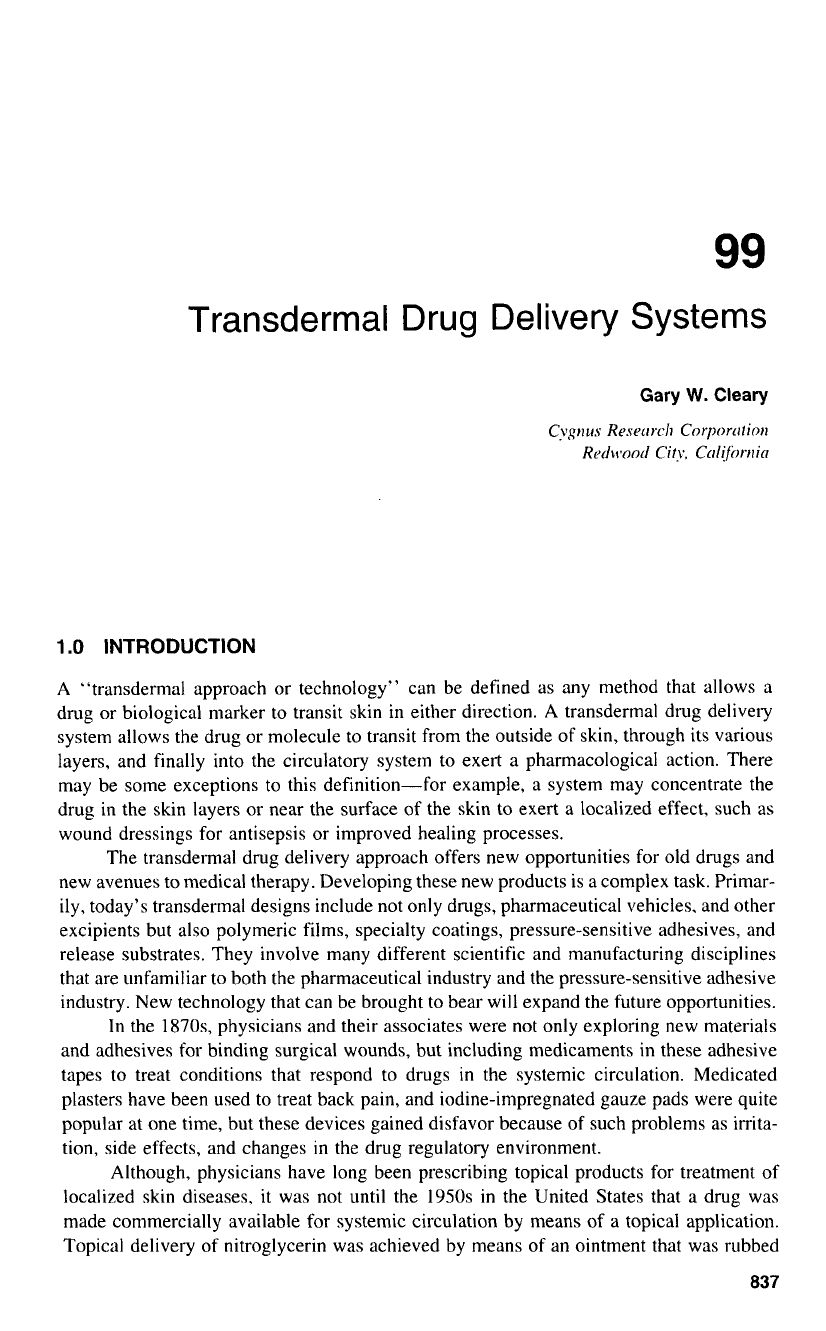
Transdermal Drug Delivery Systems
1
.O
INTRODUCTION
A “transdermal approach or technology” can be defined as any method that allows a
drug or biological marker
to
transit skin in either direction. A transdermal drug delivery
system allows the drug or molecule to transit from the outside of skin, through its various
layers, and finally into the circulatory system to exert a pharmacological action. There
may be some exceptions
to
this definition-for example, a system may concentrate the
drug in the skin layers or near the surface of the skin to exert a localized effect, such as
wound dressings for antisepsis or improved healing processes.
The transdermal drug delivery approach offers new opportunities for old drugs and
new avenues to medical therapy. Developing these new products is a complex task. Primar-
ily, today’s transdermal designs include not only drugs, pharmaceutical vehicles. and other
excipients but also polymeric films, specialty coatings, pressure-sensitive adhesives, and
release substrates. They
involve
many different scientific and manufacturing disciplines
that are unfamiliar
to
both the pharmaceutical industry and the pressure-sensitive adhesive
industry. New technology that can be brought
to
bear will expand the future opportunities.
In the
1870s,
physicians and their associates were
not
only exploring new materials
and adhesives for binding surgical wounds, but including medicaments in these adhesive
tapes
to
treat conditions that respond to drugs
in
the systemic circulation. Medicated
plasters have been used to treat back pain, and iodine-impregnated gauze pads were quite
popular at one time, but these devices gained disfavor because
of
such problems as irrita-
tion, side effects, and changes in the drug regulatory environment.
Although, physicians have long been prescribing topical products for treatment of
localized skin diseases. it was not until the
1950s
in the United States that a drug was
made commercially available for systemic circulation by means
of
a topical application.
Topical delivery of nitroglycerin was achieved by means of an ointment that was rubbed
837
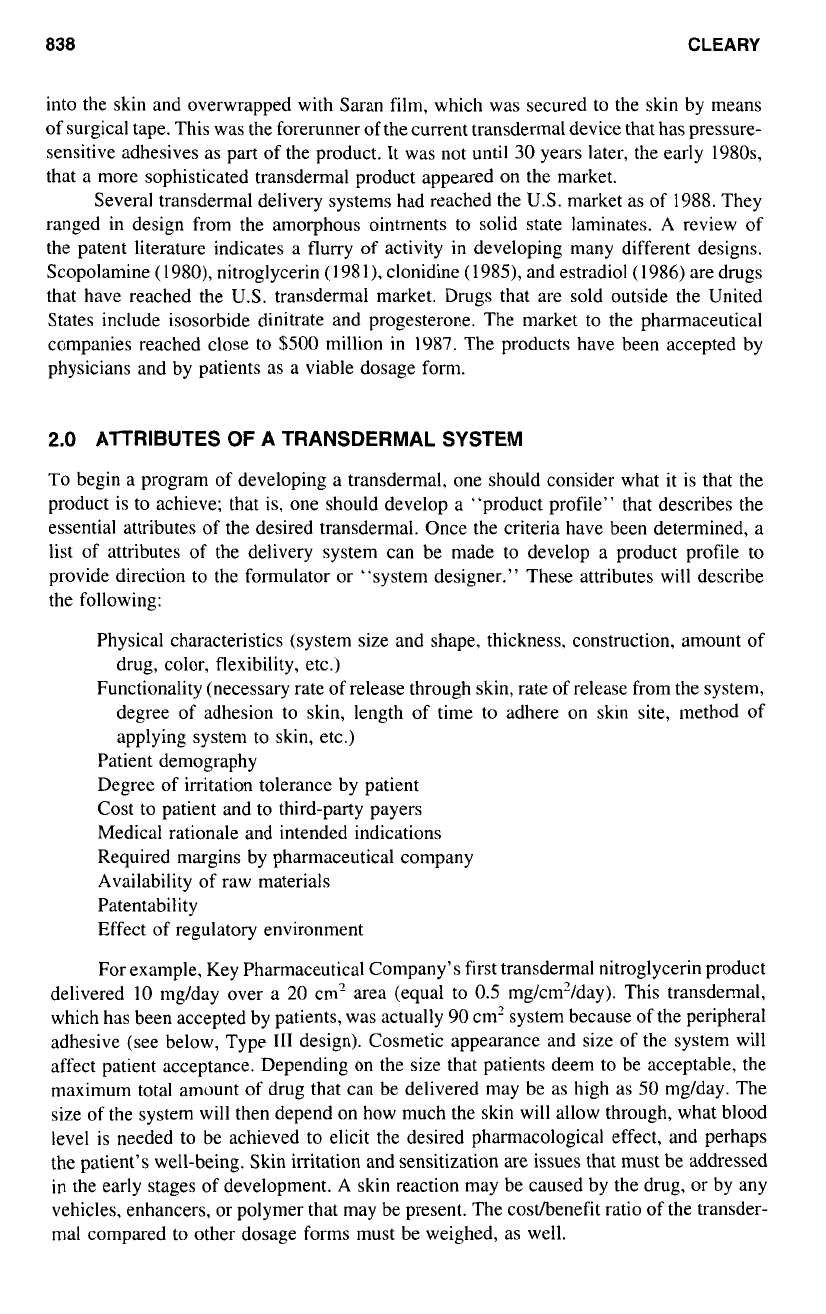
838
CLEARY
into the skin and overwrapped with Saran film, which was secured to the skin by means
of surgical tape. This was the forerunner of the current transdermal device that has pressure-
sensitive adhesives as part
of
the product. It was not until
30
years later, the early 1980s,
that
a
more sophisticated transdermal product appeared on the market.
Several transdermal delivery systems had reached the
U.S.
market
as
of 1988. They
ranged in design from the amorphous ointments to solid state laminates.
A
review of
the patent literature indicates
a
flurry of activity in developing many different designs.
Scopolamine
(l
980), nitroglycerin
(
198
1
),
clonidine
(
1985), and estradiol
(
1986) are drugs
that have reached the
U.S.
transdermal market. Drugs that are sold outside the United
States include isosorbide dinitrate and progesterone. The market
to
the pharmaceutical
companies reached close
to
$500
million
in
1987. The products have been accepted by
physicians and by patients
as
a
viable dosage form.
2.0
ATTRIBUTES
OF
A
TRANSDERMAL SYSTEM
To
begin
a
program of developing
a
transdermal, one should consider what it is that the
product is to achieve; that
is,
one should develop
a
“product profile” that describes the
essential attributes of the desired transdermal. Once the criteria have been determined,
a
list
of
attributes
of
the delivery system can be made to develop
a
product profile to
provide direction to the formulator or “system designer.” These attributes will describe
the following:
Physical characteristics (system size and shape, thickness, construction, amount of
drug, color, flexibility, etc.)
Functionality (necessary rate of release through skin, rate of release from the system,
degree of adhesion to skin, length of time
to
adhere on skin site, method of
applying system to skin, etc.)
Patient demography
Degree
of
irritation tolerance by patient
Cost to patient and to third-party payers
Medical rationale and intended indications
Required margins by pharmaceutical company
Availability of raw materials
Patentability
Effect of regulatory environment
For example, Key Pharmaceutical Company’s first transdermal nitroglycerin product
delivered
10
mg/day over
a
20
cm’ area (equal to
0.5
mg/cm’/day). This transdermal,
which has been accepted by patients, was actually 90 cm’ system because of the peripheral
adhesive (see below, Type
111
design). Cosmetic appearance and size of the system will
affect patient acceptance. Depending on the size that patients deem to be acceptable, the
maximum total amount of drug that can be delivered may be
as
high
as
50
mg/day. The
size of the system will then depend
on
how much the skin will allow through, what blood
level is needed to be achieved to elicit the desired pharmacological effect, and perhaps
the patient’s well-being. Skin irritation and sensitization are issues that must be addressed
in the early stages
of
development.
A
skin reaction may be caused by the drug, or by any
vehicles, enhancers, or polymer that may be present. The codbenefit ratio of the transder-
mal compared to other dosage forms must be weighed,
as
well.
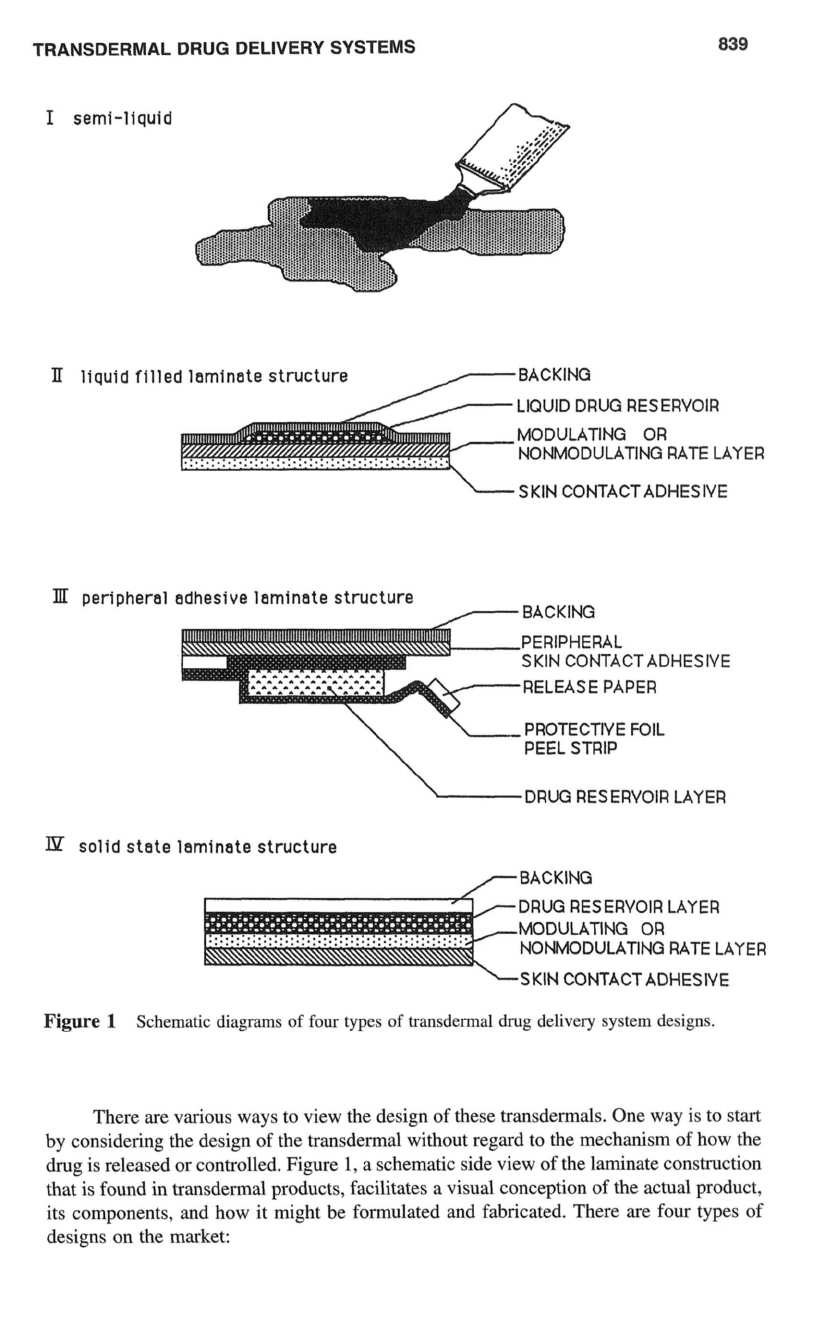
TRANSDERMAL DRUG DELIVERY SYSTEMS
I
semi-liquid
liquid filled laminate structure
/
-BACKING
839
LIQUID DRUG RESERVOIR
MODULATING
OR
NONMODULATING RATE LAYER
-SKIN CONTACTADHESIVE
peripheral adhesive laminate structure
BACKING
PERIPHERAL
SKIN CONTACTADHESIVE
RELEASE PAPER
\-,PROTECTIVE
FOIL
PEEL STRIP
DRUG RESERVOIR LAYER
m
solid state laminate structure
-BACKING
DRUG RESERVOIR LAYER
MODULATING
OR
NONMODULATING RATE LAYER
\SKIN CONTACT ADHESIVE
Figure
1
Schematic diagrams
of
four
types
of
transdermal drug delivery
system
designs.
There are various ways to view the design of these transdermals. One way is to start
by considering the design
of
the transdermal without regard to the mechanism of
how
the
drug is released
or
controlled. Figure
1,
a schematic side view of the laminate construction
that is found in transdermal products, facilitates a visual conception
of
the actual product,
its components, and how it might be formulated and fabricated. There are four types of
designs on the market:
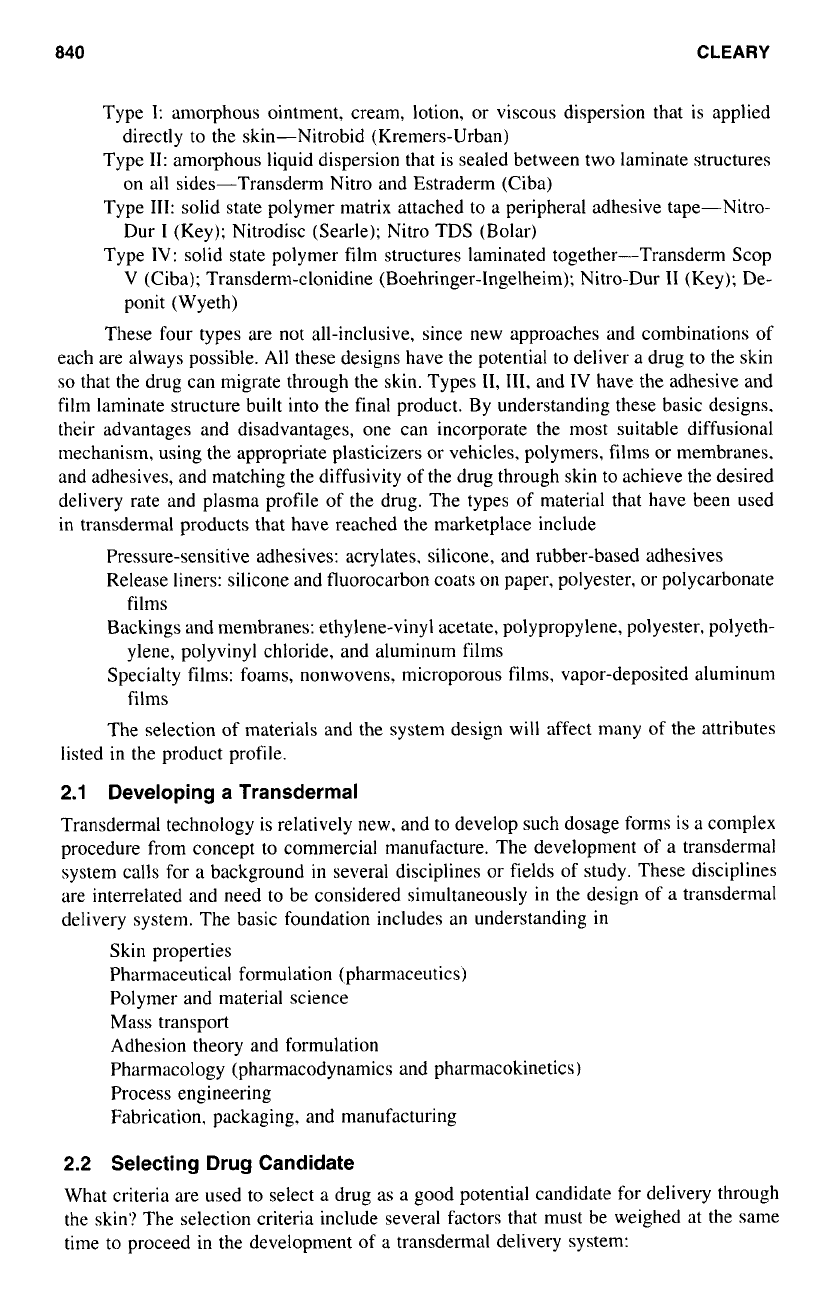
840
CLEARY
Type
I:
amorphous ointment, cream, lotion, or viscous dispersion that is applied
directly
to
the skin-Nitrobid (Kremers-Urban)
Type
11:
amorphous liquid dispersion that is sealed between
two
laminate structures
on all sides-Transderm Nitro and Estraderm (Ciba)
Type
Ill:
solid state polymer matrix attached to a peripheral adhesive tape-Nitro-
Dur
I
(Key); Nitrodisc (Searle); Nitro TDS (Bohr)
Type
IV:
solid state polymer film structures laminated together-Transderm Scop
V
(Ciba); Transderm-clonidine (Boehringer-Ingelheim); Nitro-Dur
I1
(Key); De-
ponit (Wyeth)
These four types are not all-inclusive, since new approaches and combinations
of
each are always possible.
All
these designs have the potential to deliver a drug
to
the skin
so
that the drug can migrate through the skin. Types
11,111.
and
IV
have the adhesive and
film laminate structure built into the final product. By understanding these basic designs.
their advantages and disadvantages, one can incorporate the
most
suitable diffusional
mechanism, using the appropriate plasticizers or vehicles. polymers, films or membranes.
and adhesives, and matching the diffusivity
of
the drug through skin
to
achieve the desired
delivery rate and plasma profile of the drug. The types of material that have been used
in transdermal products that have reached the marketplace include
Pressure-sensitive adhesives: acrylates, silicone, and rubber-based adhesives
Release liners: silicone and fluorocarbon coats
on
paper, polyester, or polycarbonate
Backings and membranes: ethylene-vinyl acetate, polypropylene, polyester, polyeth-
Specialty films: foams, nonwovens, microporous films, vapor-deposited aluminum
films
ylene, polyvinyl chloride, and aluminum films
films
The
selection of materials and the system design will affect many
of
the attributes
listed in the product profile.
2.1
Developing a Transdermal
Transdermal technology is relatively new, and to develop such dosage forms is a complex
procedure from concept to commercial manufacture. The development
of
a transdermal
system calls for a background
in
several disciplines or fields of study. These disciplines
are interrelated and need to be considered simultaneously
in
the design of a transdermal
delivery system. The basic foundation includes an understanding in
Skin properties
Pharmaceutical formulation (pharmaceutics)
Polymer and material science
Mass transport
Adhesion theory and formulation
Pharmacology (pharmacodynamics and pharmacokinetics)
Process engineering
Fabrication, packaging, and manufacturing
2.2
Selecting Drug Candidate
What criteria are used to select a drug as a good potential candidate for delivery through
the skin'? The selection criteria include several factors that must be weighed at the same
time to proceed in the development
of
a transdermal delivery system:

TRANSDERMAL
DRUG
DELIVERY SYSTEMS
841
Pharmacokinetic (what the body does to the drug) and pharmacodynamic (what the
Ability of the drug molecule
to
permeate skin
A targeted effective blood level
Necessity for steady state delivery,
or
shape of blood level profile
First-pass effect
of
the drug (high initial metabolism in the liver)
Amount of drug needed
Estimated size
of
system
Need for skin penetrant enhancers to increase the amount of drug throughout
Skin toxicity (irritation, sensitization)
Side effects
of
drug
Diffusional and solubility properties of drug
drug does
to
the body) information about the drug
3.0
FUTURE APPROACHES TO TRANSDERMAL DELIVERY
SYSTEMS
Transdennal delivery systems have reached the marketplace and have achieved widespread
acceptability
in
therapeutics today. However, to achieve success as a dosage form, the
selection and development of a drug candidate for transdermal delivery must be justifiable
economically for both the patient and the manufacturer and must have a sound therapeutic
rationale. There may be opportunity to expand a particular drug’s current market if that
market is quite small. This was seen with nitroglycerin, which after a century of use had
a market
of
less than
$30
million/year. Five years after the first modern transdermal was
introduced, however, the nitroglycerin market had exceeded
$300
million/year.
Not all drugs penetrate the skin easily at suitable therapeutic rates. If ways were
found to put them through skin at higher rates of diffusion, a new transdermal market
could be made. Some ways to attain suitable permeation rates could be through optimizing
the formulation, changing the lipid solubility or physical properties through synthesis of
new derivatives (homologues, analogues, or prodrugs)
to
effect an improvement over the
parent. or changing the skin permeability by means of chemical or electronic enhancers.
Today, optimizing the formulation of a drug
in
a transdermal for passive diffusion is the
predominant developmental approach. However, future approaches may include molecular
modification of the drug, or using chemical or electronic means to increase skin permeation.
With the advent of post-World War I1 technology of electronics, medicine, and
chemistry to produce a diversity of analytical instrumentation and sensitive drug assay
methodology, combined with a better understanding of how the body affects drug metabo-
lism, there have been advances in equipment and synthetic chemicals
to
produce new
polymers, new film coatings. and new fabricating techniques. These innovations, as well
as recent changes
in
the regulatory climate, and pressures to produce off-patent drug
entities, are allowing the more venturesome to explore new ways to deliver drugs to the
body. In this developmental climate comes a revitalization of the technique of using the
skin as the portal
of
entry for drugs by means
of
transdermal delivery systems.
